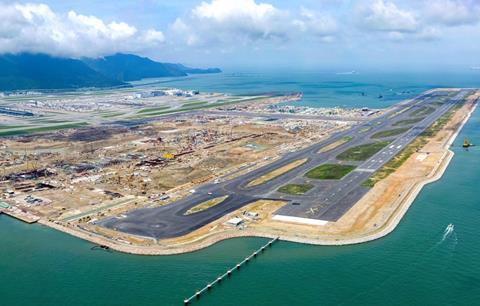Pilot representatives are urging crews to be particularly cautious when conducting approaches to Hong Kong’s new third runway, owing to potential weather effects and the proximity of terrain.
The new runway 25R/07L is located to the north of the airport.
Hong Kong’s previous northern runway has been redesignated as a centre runway, 25C/07C, and is being closed for reconfiguration work.
NOTAM information from the airport informs pilots that the ILS approach from the east to the new 25R is a two-part process consisting of an area navigation transition and an ILS final segment.
“This is due to proximity to terrain and possible glideslope interference by terrain,” says the international pilot federation IFALPA in a safety bulletin.
It points out that Hong Kong’s highest peak – Tai Mo Shan, which rises to over 3,200ft – lies on the 25R approach path.

The area navigation part of the procedure takes inbound aircraft just south of the peak, requiring them to maintain a mandatory 3,800ft over the nearby waypoint SAGNI, before descending to waypoint TOPUN at around 2,700ft, and crossing a point designated VH536 – situated shortly before the final approach point – at a required 1,800ft.
But the federation cautions that pilots could find they are above the glideslope at SAGNI under certain meteorological conditions, particularly if temperatures are high and during tailwinds.
“Conservative configuration may be required to achieve the published profile while avoiding [ground-proximity] warnings,” it states.
The ILS approach commences from the waypoint TOPUN, from where glideslope integrity can be guaranteed.
Crews are being cautioned not to engage approach mode before reaching TOPUN, and the federation is warning that this crucial instruction “may not be easily visible” on certain ILS approach charts.
Descending via the area navigation transition and complying with the mandatory 1,800ft height restriction at VH536 will enable glideslope capture from below, before the final approach point. If the aircraft is already established on the glideslope before VH536 the restriction does not apply.
ILS approaches to Hong Kong from the east had previously been a safety focus following several incidents in which Boeing 787s experienced adverse autopilot behaviour during localiser capture, prompting warnings that aircraft could inadvertently stray close to high terrain.
This situation has been addressed by Boeing through the introduction of new software, implementation of which is the subject of a recently-issued proposal from the US FAA.


























